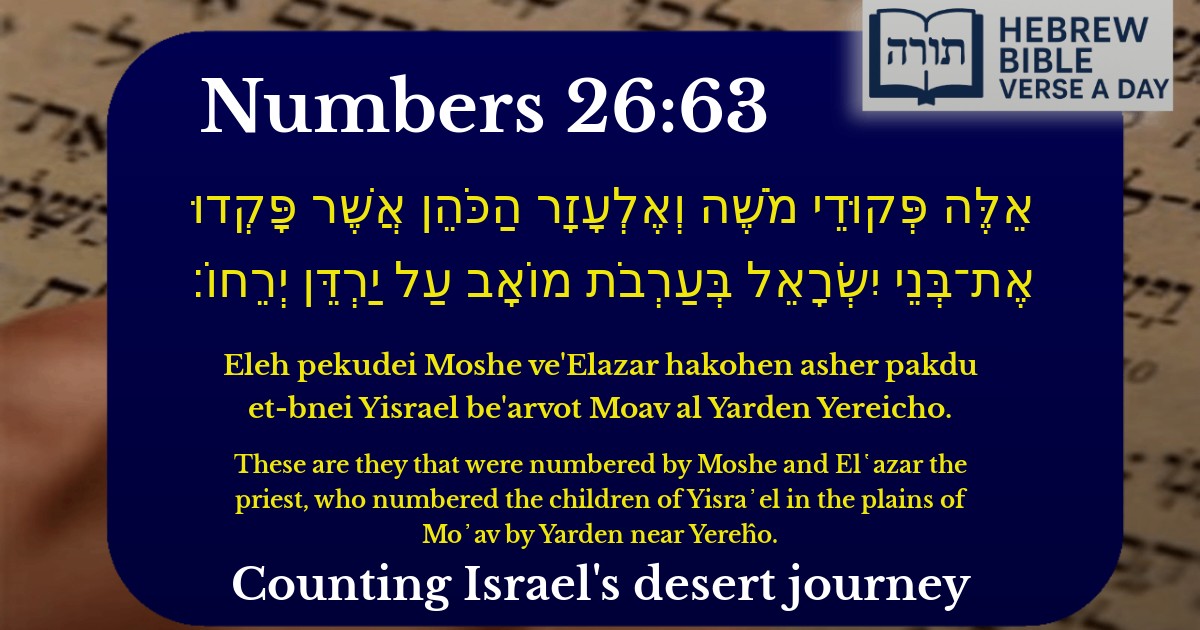Frequently Asked Questions
Q: What is the significance of the census in Numbers 26:63?
A: The census in Numbers 26:63 was taken to count the new generation of Israelites who would enter the Land of Israel, replacing those who perished in the wilderness. Rashi explains that this census showed G-d's love for the Jewish people, as He counted them frequently, especially before major events like entering the Land.
Q: Why were Moshe and Elazar the ones conducting the census?
A: Moshe, as the leader, and Elazar, as the High Priest, were responsible for counting the people because it was a sacred task connected to the nation's spiritual and physical preparation for entering Israel. The Rambam notes that leaders and priests oversee such matters to ensure accuracy and holiness.
Q: Where exactly were the Israelites counted in this verse?
A: The verse specifies they were counted in the plains of Moav by the Jordan River near Jericho. This location was their final encampment before entering the Land of Israel, as explained in the Midrash, symbolizing their transition from wandering to settling in the Promised Land.
Q: How does this census differ from earlier ones in the Torah?
A: Earlier censuses (like in Exodus and Numbers 1) counted the generation that left Egypt, while this one counted their children, who would inherit the Land. The Talmud (Bava Batra 121b) teaches that this highlights the continuity of the Jewish people despite the setbacks in the wilderness.
Q: What lesson can we learn from this verse today?
A: This verse teaches the importance of unity and preparation before embarking on a major journey or mission. Just as the Israelites were counted before entering Israel, we too should take stock of our spiritual and communal strengths when facing new challenges, as emphasized in Jewish tradition.


Context of the Verse
The verse (Bamidbar 26:63) appears in the Torah portion of Pinchas and records the census of Bnei Yisrael conducted by Moshe and Elazar the Kohen in the plains of Moav, near the Jordan River opposite Yericho. This census took place shortly before Bnei Yisrael were to enter Eretz Yisrael, replacing the previous generation that perished in the wilderness.
Rashi's Explanation
Rashi (26:63) notes that this census was distinct from the earlier one in the wilderness (Bamidbar 1) because it was conducted jointly by Moshe and Elazar, whereas the first census was conducted by Moshe and Aharon. The shift reflects the transition of leadership, as Aharon had passed away (as recorded earlier in Bamidbar 20), and Elazar now served as Kohen Gadol in his place.
Purpose of the Census
The Ramban (Bamidbar 26:63) explains that this census served multiple purposes:
Significance of the Location
The Sforno emphasizes that the census took place "in the plains of Moav by the Jordan near Yericho" to highlight the imminent transition into Eretz Yisrael. This location was the final stop before crossing the Jordan, symbolizing the completion of their journey and the beginning of a new era.
Midrashic Insights
The Midrash Tanchuma (Pinchas 9) connects this census to the concept of hashgacha pratit (divine providence), noting that each individual was counted to show their importance before Hashem. Additionally, the Midrash highlights that this census included only those eligible to enter the land, reinforcing the theme of renewal and continuity for the next generation.